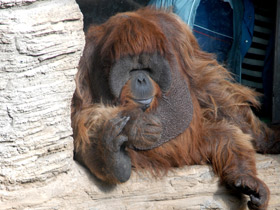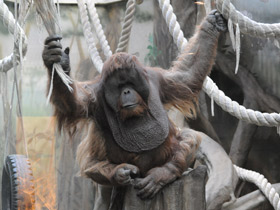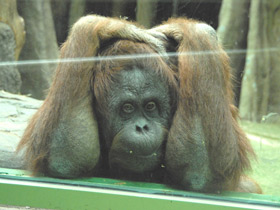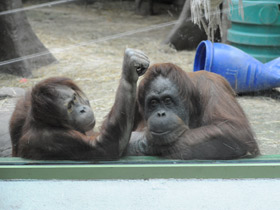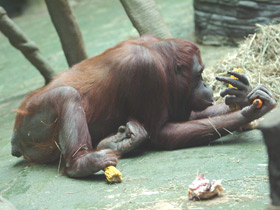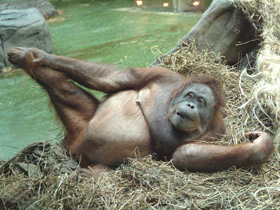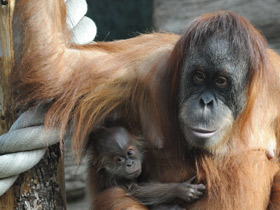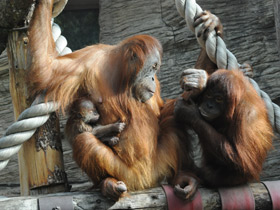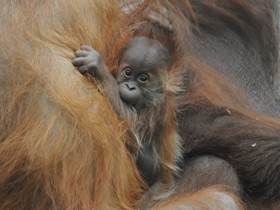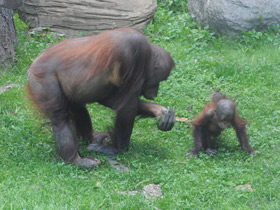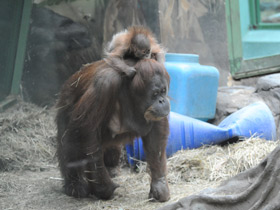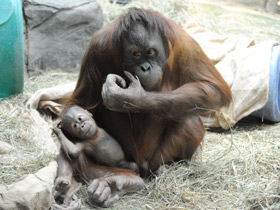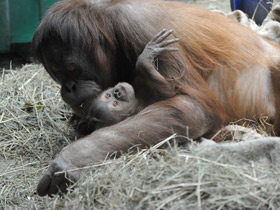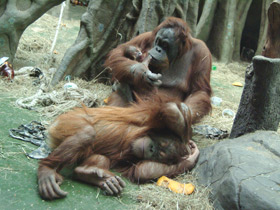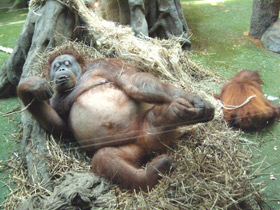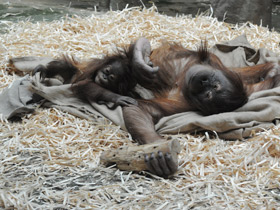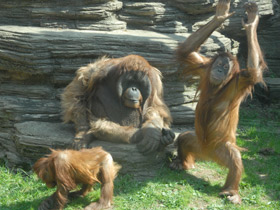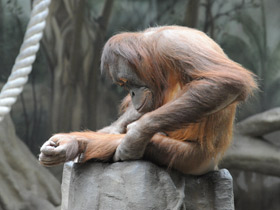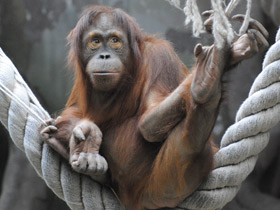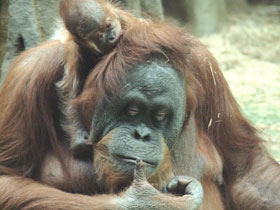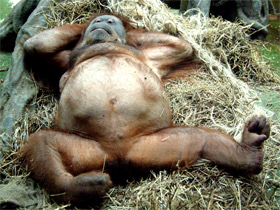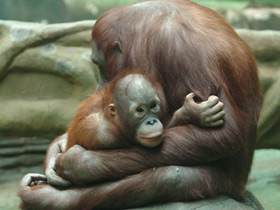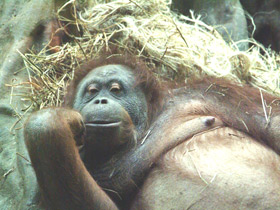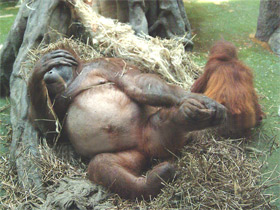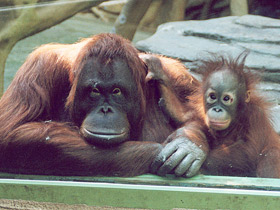The Sumatran orangutan (Pongo abelii)
 The Sumatran orangutan (Pongo abelii) is included in the IUCN Red List as an "endangered species"
The Sumatran orangutan (Pongo abelii) is included in the IUCN Red List as an "endangered species"
The Sumatran orangutan (Pongo abelii) is one of the three species of orangutans. Critically endangered, and found only in the north of the Indonesian island of Sumatra, it is rarer than the Bornean orangutan but more common than the recently identified Tapanuli orangutan, also found in Sumatra. Its common name is based on two separate local words, "orang" ("people" or "person") and "hutan" ("forest"), derived from Malay, and translates as 'person of the forest'.
Description
Male Sumatran orangutans grow to about 1.7 m (5.6 ft) tall and 90 kg (200 lb), while females are smaller, averaging 90 cm (3.0 ft) and 45 kg (99 lb). Compared to the Bornean species, Sumatran orangutans are thinner and have longer faces; their hair is longer with a paler red color.
Behaviour and ecology
Compared with the Bornean orangutan, the Sumatran orangutan tends to be more frugivorous and especially insectivorous. Preferred fruits include figs and jackfruits. It will also eat bird eggs and small vertebrates. Sumatran orangutans spend far less time feeding on the inner bark of trees.
Wild Sumatran orangutans in the Suaq Balimbing swamp have been observed using tools. An orangutan will break off a tree branch that is about a foot long, snap off the twigs and fray one end with its teeth. The orangutan will use the stick to dig in tree holes for termites. They will also use the stick to poke a bee's nest wall, move it around and catch the honey. In addition, orangutans use tools to eat fruit. When the fruit of the Neesia tree ripens, its hard, ridged husk softens until it falls open. Inside are seeds that the orangutans enjoy eating, but they are surrounded by fiberglass-like hairs that are painful if eaten. Tools are created differently for different uses. Sticks are often made longer or shorter depending on whether they will be used for insects or fruits. If a particular tool proves useful, the orangutan will often save it. Over time, they will collect entire "toolboxes". A Neesia-eating orangutan will select a five-inch stick, strip off its bark, and then carefully collect the hairs with it. Once the fruit is safe, the ape will eat the seeds using the stick or its fingers. Although similar swamps can be found in Borneo, wild Bornean orangutans have not been seen using these types of tools.
NHNZ filmed the Sumatran orangutan for its show Wild Asia: In the Realm of the Red Ape; it showed one of them using a simple tool, a twig, to pry food from difficult places. There is also a sequence of an animal using a large leaf as an umbrella in a tropical rainstorm.
As well as being used as tools, tree branches are a means of transportation for the Sumatran orangutan. The orangutans are the heaviest mammals to travel by tree, which makes them particularly susceptible to the changes in arboreal compliance. To deal with this, their locomotion is characterized by slow movement, long contact times, and an impressively large array of locomotors postures. Orangutans have even been shown to utilize the compliance in vertical supports to lower the cost of locomotion by swaying trees back and forth and they possess unique strategies of locomotion, moving slowly and using multiple supports to limit oscillations in compliant branches, particularly at their tips.
The Sumatran orangutan is also more arboreal than its Bornean cousin; this could be because of the presence of large predators, like the Sumatran tiger. It moves through the trees by quadrumanous locomotion and semibrachiation.
As of 2015, the Sumatran orangutans species only has approximately 7,000 remaining members in its population. The World Wide Fund for Nature is thus carrying out attempts to protect the species by allowing them to reproduce in the safe environment of captivity. However, this comes at a risk to the Sumatran orangutan's native behaviors in the wild. While in captivity, the orangutans are at risk to the "Captivity Effect": animals held in captivity for a prolonged period will no longer know how to behave naturally in the wild. Being provided with water, food, and shelter while in captivity and lacking all the challenges of living in the wild, captive behaviour becomes more exploratory in nature.
A repertoire of 64 different gestures in use by orangutans has been identified, 29 of which are thought to have a specific meaning that can be interpreted by other orangutans the majority of the time. Six intentional meanings were identified: Affiliate/Play, Stop action, Look at/Take object, Share food/object, Co-locomote and Move away. Sumatran orangutans do not use sounds as part of their communication, which includes a lack of audible danger signals, but rather base their communication on gestures alone.
Diet
Sumatran orangutans are primarily frugivores, favoring fruits consisting of a large seed and surrounded by a fleshy substance, such as durians, lychees, jackfruit, breadfruit, and fig fruits. Insects are also a huge part of the orangutan's diet; the most consumed types are ants, predominantly of the genus Camponotus (at least four species indet.). Their main diet can be broken up into five categories: fruits, insects, leaf material, bark and other miscellaneous food items. Studies have shown that orangutans in the Ketambe area in Indonesia ate over 92 different kinds of fruit, 13 different kinds of leaves, 22 sorts of other vegetable material such as top-sprouts, and pseudo-bulbs of orchids. Insects included in the diet are numbered at least 17 different types. Occasionally soil from termite mounds were ingested in small quantities. When there is low ripe fruit availability, Sumatran orangutans will eat the meat of the slow loris, a nocturnal primate. Water consumption for the orangutans was ingested from natural bowls created in the trees they lived around. They even drank water from the hair on their arms when rainfall was heavy.
Meat-eating
Meat-eating happens rarely in Sumatran orangutan, and orangutans do not show a male bias in meat-eating. Research in the Ketambe area reported cases of meat-eating in wild Sumatran orangutans, of which nine cases were of orangutans eating slow lorises. The research shows, in the most recent three cases of slow lorises eaten by Sumatran orangutan, a maximum mean feeding rate of the adult orangutan for an entire adult male slow loris is 160.9 g/h and, of the infant, 142.4 g/h. No cases have been reported during mast years, which suggests orangutans take meat as a fallback for the seasonal shortage of fruits; preying on slow loris occurs more often in periods of low fruit availability. Similar to most primate species, orangutans appear to only share meat between mother and infants.
Threats
Sumatrans encounter threats such as logging (both legal and illegal), wholesale conversion of forest to agricultural land and oil palm plantations, and fragmentation by roads. Oil companies use a method of deforestation to re-use land for palm oil. This land is taken from the forest in which Sumatran orangutans live. An assessment of forest loss in the 1990s concluded that forests supporting at least 1,000 orangutans were lost each year within the Leuser Ecosystem alone.
Conservation status
The Sumatran orangutan is endemic to the north of Sumatra. In the wild, Sumatran orangutans only survive in the province of Nanggroe Aceh Darussalam (NAD), the northernmost tip of the island. The primate was once more widespread, as they were found farther to the south in the 19th century, such as in Jambi and Padang. There are small populations in the North Sumatra province along the border with NAD, particularly in the Lake Toba forests. A survey in the Lake Toba region found only two inhabited areas, Bukit Lawang (defined as the animal sanctuary) and Gunung Leuser National Park. Bukit Lawang is a jungle village, 90 kilometres (56 mi) northwest of Medan, situated at the eastern side of Gunung Leuser National Park. An orangutan sanctuary was set up here by a Swiss organisation in the 1970s to attempt to rehabilitate orangutans captured from the logging industry. The rangers were trained to teach the orangutans vital jungle skills to enable them to reintegrate into the forest, and provided additional supplementary food from a feeding platform. However, within the last few years supplementary feeding has ceased as the orangutan rehabilitation program has been deemed a success, the orangutans having been fully rehabilitated, and the jungle (or the remaining part of) is now at saturation point, so the sanctuary no longer accepts new orphaned orangutans.

















